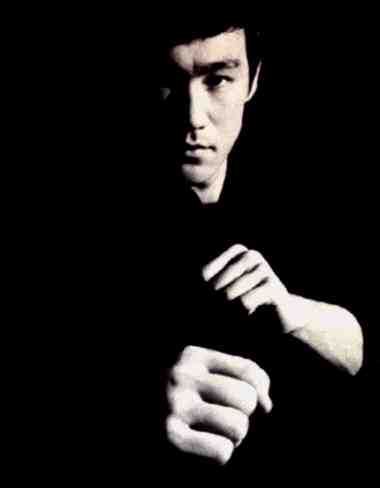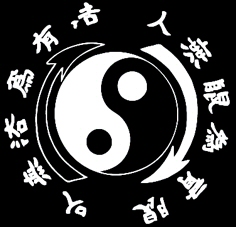Academy of Jeet Kune Do Fighting Technology
Athens
Greece
Jun Fan Jeet Kune Do Instructor
Vagelis Zorbas


Trapping
Kali's Devastating Range
The
most damaging range in the Filipino Martial Arts is trapping range. You
can barrage your opponent with knees, elbows, headbutts, low line kicks,
stomps, sweeps and standing choke outs. In the Filipino Martial Arts,
trapping doesn't just refer to techniques, but to the range itself. When
an animal is trapped in a cage, it cannot move forward, backward or side
to side. This is what the opponent will feel like against a trapper.
Trapping range is reached when two fighters start our in boxing range,
where all the punching takes place. The two fighters now get into a clinch
where they are both too close to punch. This is trapping range, where
muscle destruction's, hand immobilization's, knees, elbows and headbutts
take place. While in trapping range, you will be using a lot of forward
pressure while you are hitting. It is very hard to defend against all
these strikes when you are being forced to back pedal.
TRAPPING
TECHNIQUES
There are also many different hand trapping and immobilizing techniques in
Kali. When an opponent tries to block a strike, that block can be turned
into a devastating trap. Kali has traps that will cross an opponents
hands, so that he can't block any more. These traps are very similar to
Wing-Chun Kung Fu. When the opponents hands are trapped, the Kali man can
then headbutt, knee and elbow. Hand trapping almost always follows some
type of muscle or nerve destruction. Hand trapping skills are important to
offset an opponents blocks. An opponents block is referred to as an
obstruction, and Kali teaches you to remove these obstructions, or go
around them. This training enables you to hit your opponent at the same
time you are immobilizing his arms. The best traps will have are tying up
your opponents two arms with just one of yours. Now, you can strike with
all of your close range weapons, while his arms are trapped.
TRAPPING
COMES FROM THE WEAPON
The bulk of the trapping in the Filipino Martial Arts, comes from the
single and double dagger systems. The Filipino's believe that if you can
trap with the weapon, your empty hand trapping will be enhanced. The empty
hand, and the knife, both seek the same path, destroying and removing
obstructions. The main difference between being armed and unarmed, is that
in trapping range, the empty hand needs a solid hit, but the knife just
has to graze the opponent to cause damage. In a stick fight, two
combatants can clash and not have enough room to swing. This is the range
where the two fighters can trap the hand or the weapon. Headbutts, knees,
and elbows will also fly in this situation.
TRAPPING VS GRAPPLING
Trapping skill can help against fighting a grappler or wrestler. Whenever
the grappler tries to grab you, you must control center line, and let the
elbows, knees and headbutts fly. A wrestler or streetfighter can't grab,
lock or throw you while he is being barraged with these shots. Unlike
punches or kicks, knees, elbows, and headbutts almost always break the
skin when they hit the face or head.
In the Filipino Martial Arts, elbows are usually thrown in combination. A
Kali man can hit in combination with both elbows at an incredible speed.
The main targets for the elbows are the hands, the bicep or tricep, the
deltoid, the collarbone, and the face and head. The elbow is also used to
defend against kicks or knees.
The knee attack is usually aimed at the nerve in the thigh or at the
groin. After the knee is throw, the foot can then stomp down on your
opponents instep. The knee is also thrown in fast combinations while your
upper body is striking.
The headbutt can be the most damaging weapon in trapping range. The
headbutt is always performed with the top of the head.
The general rule of headbutting is if you see your target, you're
positioning is wrong." The headbutt is aimed at the eyes, cheek,
mouth and nose. It can be used as a defense to a grab or while your
opponents hands are trapped.
Foot sweeping is another tool used in trapping range. One of the best
times to sweep your opponent is when you are in trapping range and he
covers his face with his hands. It is hard to score when your opponent
covers up, so you can just re-route your attack to the low line and sweep
out one of his legs. A sweep can also follow a knee to the thigh to weaken
his balance.
There are also may standing chokes done in trapping range. While you have
your opponents hands immobilized, you can use your free hand to perform
one of many lapel chokes. Lapel chokes and other standing chokes can be
found in such arts as Kali, Jiu Jitsu and Judo.
CONCLUSION
So you see, in long or midrange, the only tools you have are punches, or
kicks. In Kali trapping range, you have elbows, headbutts, knees, stomps,
sweeps, chokes and bites. These tools combined with lots of forward
pressure makes a very formidable opponent. Trapping range is the range
most people aren't familiar with. It is very important to be able to
function in close range. When most fighters clash in midrange, the fight
usually ends up on the ground. Learning Kali's trapping range, will give
any Martial Artist, a whole new way of looking at combat.
GLOSSARY:
Trapping: the art of immobilizing one or both of your opponent's arms so
that you can hit him. This can also apply to immobilizing his feet.
Attributes: a quality or skill that a person possesses.
Sensitivity: the ability to feel your opponent's movements when you are in
physical contact.
Atapi: Filipino term. A palm slap used to trap the arm. It can be done
with either hand and from any lead In some dialects, the work itulak is
used.
Hilahin: Filipino term. A trap involving the pulling of the opponent's arm
across the center of his body.
Gunting: Filipino term. A scissors-like motion, usually a strike intended
to shock the nervous system. This is generally delivered to the muscle
and/or nerves of a limb.
Kaukit: Filipino term. The trapping of your opponent's foot. The purpose
is to off-balance or pin him in place.
Pak sao: Chinese term. see Atapi.
Lop sao: Chinese term. see Hilahin.
Reference position: position in which both partners are in the same lead
stance with their front wrists touching.
